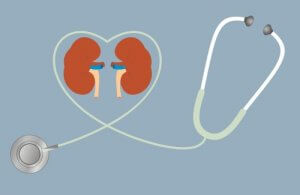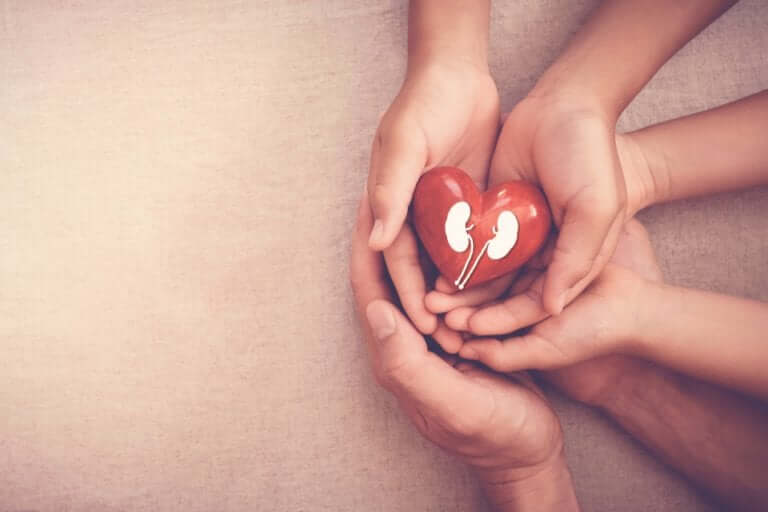Childhood Kidney Diseases: What You Should Know

Some childhood kidney diseases can already become apparent in the neonatal period. Most are asymptomatic and may go unnoticed unless there is a family history, or they’ve been detected in the gestation period.
Acute renal disorders in the severely ill newborn are more frequent and doctors will treat them once the respiratory, hemodynamic, neurological and infectious disease systems have stabilized.
The kidneys are generally sufficiently prepared to perform their role in most newborn babies, even premature ones, unless severe primary nephropathies exist.
Childhood kidney diseases
Acute kidney damage
We’re talking here about acute kidney failure, although there’s no consensus on defining it for infants. To diagnose and control it, doctors will need to measure blood creatinine levels. In addition to that, they’ll test the volume of urine excreted by the newborn baby or child. They’ll also carry out other tests for a correct diagnosis.
There is a clear relationship between the presence of acute renal failure and the risk of death, depending on the severity of the renal failure.
Different medications or procedures such as peritoneal dialysis or hemodialysis can be used for treatment.
Vascular Thrombosis
Thrombosis is the blockage of blood flow in a blood vessel, which may be an artery or a vein. Renal venous thrombosis is the most common spontaneous venous thrombosis in newborn babies.
Risk factors for renal venous thrombosis include:
- Premature birth
- Perinatal asphyxia
- Dehydration
- Being the child of a diabetic mother
Certain prothrombotic conditions (which increase the probability of suffering from thrombosis) and genetic alterations may also act as risk factors.
The classic symptoms of renal venous thrombosis are:
- Hematuria (blood in the urine)
- Palpable abdominal mass
- Thrombopenia
- High blood pressure
The most commonly used diagnostic method is a renal Doppler ultrasound. To try to cure it, doctors will prescribe medications such as heparin.
Renal arterial thrombosis is much rarer and in most cases occurs after catheterization through the umbilical artery.

High blood pressure
In childhood, doctors define high blood pressure as the presence of blood pressure (systolic or diastolic) consistently above the 95th percentile for age, sex, and height.
In newborns, there is no clear definition, as blood pressure varies in the early days, and weight and gestational age influence its values.
The causes of high blood pressure in newborn babies are many, as babies have some specific risk factors (umbilical catheterization, bronchopulmonary dysplasia…) that add to other common causes.
For its diagnosis and study, it’s essential to compile a comprehensive medical record, assessing the medication being administered and whether it’s painful, as this is a frequent cause of increased blood pressure.
It may also be necessary to carry out a blood and urine test, as well as a Doppler ultrasound or cardiac ultrasound. Antihypertensive medication is usually used for treatment.
Nephrocalcinosis as one of the childhood kidney diseases
This illness appears as a result of deposits of calcium in the kidney. However, the exact causes of this disease aren’t known, although it has been shown that there is a relationship with premature birth.
For its diagnosis and follow up, the most common test is the renal ultrasound. Likewise, for its treatment it may be necessary to administer certain medications, although in many cases this disease clears up by itself.
Urinary tract infection (UTI)
Urinary tract infections in infants and children are more common in males, However, in adulthood, it’s more common in females. The main bacteria that cause this infection are E. coli and Klebsiella.
The most common symptoms are
- Fever
- Irritability
- Refusal to eat
- Vomiting
- Poor weight gain
- Jaundice
Urinary tract infections are diagnosed by means of a urine culture. The treatment, once the presence of bacteria in the urine is detected, is usually through antibiotics.

Other childhood kidney diseases
There are many kidney diseases that can occur in the neonatal period or even throughout childhood. In addition to the ones we’ve already named, other reasonably common ones are:
- Tubulopathies
- Congenital nephrotic syndrome
- Congenital mesoblastic nephroma
- Renal cancer
- Chronic renal disease of neonatal onset
- Multi-cystic renal dysplasia
- Dilatation of the renal pelvis (pyelectasis)
- Renal ectopia
- Renal fusion
- Pyeloureteral stenosis
- Renal cysts
What to do in case of kidney disease in childhood?
If your child has been diagnosed with kidney disease, then pediatricians and nephrologists will perform all the necessary tests in order to obtain a correct diagnosis and treatment.
It’s very important to monitor these illnesses, even if symptoms seem to go away. In addition, always make sure to follow the advice of your doctor or medical professional regarding check-ups and treatment.
Some childhood kidney diseases can already become apparent in the neonatal period. Most are asymptomatic and may go unnoticed unless there is a family history, or they’ve been detected in the gestation period.
Acute renal disorders in the severely ill newborn are more frequent and doctors will treat them once the respiratory, hemodynamic, neurological and infectious disease systems have stabilized.
The kidneys are generally sufficiently prepared to perform their role in most newborn babies, even premature ones, unless severe primary nephropathies exist.
Childhood kidney diseases
Acute kidney damage
We’re talking here about acute kidney failure, although there’s no consensus on defining it for infants. To diagnose and control it, doctors will need to measure blood creatinine levels. In addition to that, they’ll test the volume of urine excreted by the newborn baby or child. They’ll also carry out other tests for a correct diagnosis.
There is a clear relationship between the presence of acute renal failure and the risk of death, depending on the severity of the renal failure.
Different medications or procedures such as peritoneal dialysis or hemodialysis can be used for treatment.
Vascular Thrombosis
Thrombosis is the blockage of blood flow in a blood vessel, which may be an artery or a vein. Renal venous thrombosis is the most common spontaneous venous thrombosis in newborn babies.
Risk factors for renal venous thrombosis include:
- Premature birth
- Perinatal asphyxia
- Dehydration
- Being the child of a diabetic mother
Certain prothrombotic conditions (which increase the probability of suffering from thrombosis) and genetic alterations may also act as risk factors.
The classic symptoms of renal venous thrombosis are:
- Hematuria (blood in the urine)
- Palpable abdominal mass
- Thrombopenia
- High blood pressure
The most commonly used diagnostic method is a renal Doppler ultrasound. To try to cure it, doctors will prescribe medications such as heparin.
Renal arterial thrombosis is much rarer and in most cases occurs after catheterization through the umbilical artery.

High blood pressure
In childhood, doctors define high blood pressure as the presence of blood pressure (systolic or diastolic) consistently above the 95th percentile for age, sex, and height.
In newborns, there is no clear definition, as blood pressure varies in the early days, and weight and gestational age influence its values.
The causes of high blood pressure in newborn babies are many, as babies have some specific risk factors (umbilical catheterization, bronchopulmonary dysplasia…) that add to other common causes.
For its diagnosis and study, it’s essential to compile a comprehensive medical record, assessing the medication being administered and whether it’s painful, as this is a frequent cause of increased blood pressure.
It may also be necessary to carry out a blood and urine test, as well as a Doppler ultrasound or cardiac ultrasound. Antihypertensive medication is usually used for treatment.
Nephrocalcinosis as one of the childhood kidney diseases
This illness appears as a result of deposits of calcium in the kidney. However, the exact causes of this disease aren’t known, although it has been shown that there is a relationship with premature birth.
For its diagnosis and follow up, the most common test is the renal ultrasound. Likewise, for its treatment it may be necessary to administer certain medications, although in many cases this disease clears up by itself.
Urinary tract infection (UTI)
Urinary tract infections in infants and children are more common in males, However, in adulthood, it’s more common in females. The main bacteria that cause this infection are E. coli and Klebsiella.
The most common symptoms are
- Fever
- Irritability
- Refusal to eat
- Vomiting
- Poor weight gain
- Jaundice
Urinary tract infections are diagnosed by means of a urine culture. The treatment, once the presence of bacteria in the urine is detected, is usually through antibiotics.

Other childhood kidney diseases
There are many kidney diseases that can occur in the neonatal period or even throughout childhood. In addition to the ones we’ve already named, other reasonably common ones are:
- Tubulopathies
- Congenital nephrotic syndrome
- Congenital mesoblastic nephroma
- Renal cancer
- Chronic renal disease of neonatal onset
- Multi-cystic renal dysplasia
- Dilatation of the renal pelvis (pyelectasis)
- Renal ectopia
- Renal fusion
- Pyeloureteral stenosis
- Renal cysts
What to do in case of kidney disease in childhood?
If your child has been diagnosed with kidney disease, then pediatricians and nephrologists will perform all the necessary tests in order to obtain a correct diagnosis and treatment.
It’s very important to monitor these illnesses, even if symptoms seem to go away. In addition, always make sure to follow the advice of your doctor or medical professional regarding check-ups and treatment.
All cited sources were thoroughly reviewed by our team to ensure their quality, reliability, currency, and validity. The bibliography of this article was considered reliable and of academic or scientific accuracy.
- Bakkaloglu, S. A., & Schaefer, F. (2018). Enfermedades del riñón y del tracto urinario en niños. Brenner y Rector. El riñón.
- C. Gutiérrez Segura, Á. Gómez Farpón, C. Granell Suárez. (2013). Anomalías congénitas del riñón y del tracto urinario. Pediatr Integral 2013; XVII(6): 391-401.
- Melgosa Hijosa, M., & Fons Moreno, J. (2014). ENFERMEDADES RENALES MÁS FRECUENTES EN EL PERIODO NEONATAL. Asociación Española de Nefrología Pediátrica.
This text is provided for informational purposes only and does not replace consultation with a professional. If in doubt, consult your specialist.








